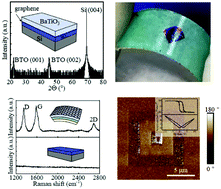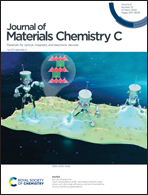Toward van der Waals epitaxy of transferable ferroelectric barium titanate films via a graphene monolayer†
Abstract
Future “Internet of Things” requires transferable ferroelectric thin films for functional devices like sensors and actuators. We report here the growth of a typical ferroelectric perovskite compound, BaTiO3, on a graphene monolayer which remains intact during the oxide growth process at high temperatures and at elevated oxygen pressure. The graphene facilitates the crystallization of BaTiO3. The growth of BaTiO3 on the graphene monolayer is found to follow the Volmer–Weber mode with the formation of three dimensional islands at the initial growth stage. Highly (001)-oriented BaTiO3 crystalline films are fabricated and can be easily exfoliated using a metal stressor layer. The graphene monolayer remains attached to the exfoliated BaTiO3 film which demonstrates good piezoelectric properties. These results not only demonstrate the possibility to fabricate high quality crystalline ferroelectric films via a graphene monolayer, but also open the pathway to realize van der Waals epitaxy ferroelectric films which can be transferred onto arbitrary substrates, particularly onto flexible substrates for wearable devices applications.



 Please wait while we load your content...
Please wait while we load your content...